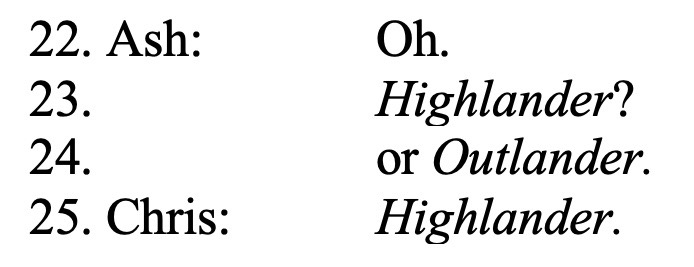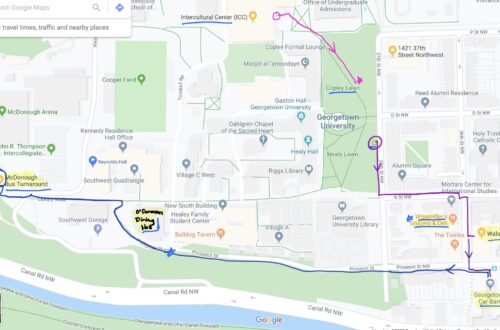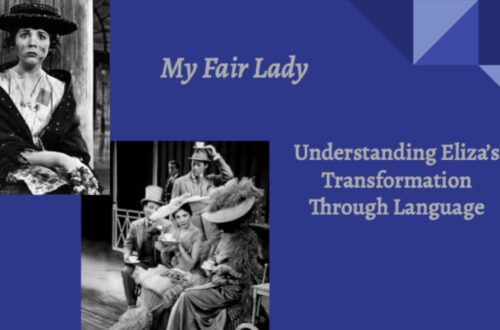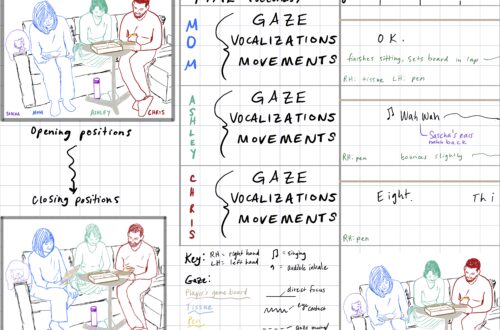Conversation Shaping: The Impact of Questions on Conversational Direction
Georgetown University, 2020. Linguistics.
[Sharing below a short paper from Discourse Analysis: Conversation, applying Sacks, Schegloff, and Jefferson (1974) to my data. My conversation data recording and transcripts are available here.]
In a pioneering article describing the way conversational turn-taking is structured, Sacks, Schegloff, and Jefferson (1974; referred to as SSJ throughout) detail fourteen “facts” (700) found to occur in natural conversations, which govern the composition and procurement of speech turns. The focus of this paper concerns certain “turn allocation techniques” (716) employed by a current speaker to select the next speaker (SSJ’s twelfth fact). In particular, I will examine the use of question-answer adjacency pairs, the first part of which (i.e., the question) not only impacts who speaks next, but also “set[s] constraints on what should be done in a next turn” (717). Such devices highlight SSJ’s assertion that conversation is “interactionally managed” (726) – that is, conditional to and shaped by the contributions of speakers. Through examining a dyadic interchange, I will demonstrate how questions influence the direction of the conversation, both through speaker selection and turn content: when one partner asks a question, the other tries to provide a relevant answer, thus following the question-asker’s lead.
The conversation here referenced began when my fiancé, Chris, and I were sharing a snack of tea and biscotti, the latter prompting the topic of our larger-scale conversation. Though we begin and end by discussing biscotti and other products we used to buy at our neighborhood farmer’s market in New York City, the bulk of our talk concerns a tangent followed and repeatedly renewed through a series of questions I ask.
Preceding the following excerpt[1], Chris has just manipulated a homonym (“dunking” and “Duncan”) to transition from talking about biscotti to making a joke (about a movie and television show). Various “contextualization cues” (Gumperz 1977) signaled to me that this was a joke (e.g., intonation, likely accompanied by a smile), and after responding with a preliminary chuckle, I concluded that there may have been more to the joke than I understood. I followed Chris’ initiation to reshape our conversational locus by asking:

I have asked a question (line 17) for which Chris is the only one present who possesses the knowledge I seek – thus, in my turn, I have selected him as speaker and directed what I wish him to provide in his turn (an answer). Though he does respond to my question about whether it is a reference I should know (rather than ignoring it or moving to another topic), he does not provide sufficient information to satisfy me, simply indicating “yeah” (line 18). I follow up with another question (“What is it,” line 19), to which he gives a brief answer that names the reference (line 21), thus repeating the pattern of turn speaker and content selection through asking a question (a pattern which continues in the subsequent excerpts).
Because I am unfamiliar with the subject of his answer (The Highlander, line 21) and think he may have provided incorrect information (mistaking the title of a popular book and television series), I proceed with further questions (as seen in the next excerpt), offering an opportunity to repair his possible error (SSJ fact 14). In his reply, Chris confirms that there was no error:

Unlike speakers of other “conversational styles” (to use Tannen’s 2005 term) who would (in this case, accurately) interpret my questions as an invitation to launch into a detailed explanation of their topic, Chris is still taciturn in his answer (clarifying only the title, in line 25). In none of the examples above does he elaborate within the same “turn-constructional unit” (720; SSJ fact 13); each turn ends with falling intonation and employs syntax that could signify finality of thought. This, coupled with my own preference for fast-paced turn-taking, leads me (perhaps incorrectly) to conclude each time that he has ended his turn and will say no more without prompting. His response leaves the floor open to either speaker, and since I still need information, I ask another question (excerpt below), again prescribing that he should speak next and directing what he should tell me:

My question (line 26) finally evokes the sort of response I am looking for: at line 27, Chris begins a thorough clarification and detailed explanation of The Highlander, providing me with the content I had hoped to glean through each of my previous questions.
Once armed with sufficient information to attempt to link The Highlander with something with which I am familiar, I interrupt Chris’ explanation of the storyline to ask a question that would slightly redirect the conversation; Chris accepts this shift, as shown below.

Through line 46, Chris has been outlining the plot of The Highlander; when I interrupt him (line 47), my question re-selects him as speaker, but solicits an alteration in topic (the era of the productions rather than plot). His response attends to my most recent question, showing his receptivity to my participative act: beginning line 48 and continuing for ten lines, Chris supplies a detailed, era-relevant response (this time without any prompting for elaboration) before returning to his previous focus on the storyline.
Though many further points could be taken from these excerpts, I have concentrated on SSJ’s assertions that conversation is mutually constructed and “participant-administered” (726), and that questions influence both speaker selection and turn content. Each example shows instances of “current [speaker] selects next” (716), even in a conversation with only two participants – all achieved through asking questions. Each question further shapes the conversation by defining (and curtailing) what content is appropriate for the next turn. Tangents introduced were accepted and pursued through the use of questions; participants were shown to modify whatever other intentions they may have had for their turns to ask and respond to questions (following the question-asker’s lead), thus demonstrating how question-answer adjacency pairs influence the direction of a naturally-occurring conversation.
References
Gumperz, J. (1977). Sociocultural Knowledge in Conversational Inference. In: M. Saville-Troike (ed.), 28th Annual Round Table Monograph Series on Languages and Linguistics. Washington, DC: Georgetown University Press.
Sacks, H., Schegloff, E. A., & Jefferson, G. (1974). A Simplest Systematics for the Organization of Turn-Taking for Conversation. Language, 50(4), 696-735.
Tannen, D. (2005[1984]). Conversational Style: Analyzing Talk Among Friends. Oxford: Oxford University Press.
Notes
[1] I have numbered my conversation excerpt lines according to where they appear in the complete transcript (attached) for easy reference (e.g., the first line that appears in this paper is line 17. Rather than renumbering it as “line 1,” I have continued to label it “line 17”). Additionally, my transcription conventions are indicated on the complete transcript.


